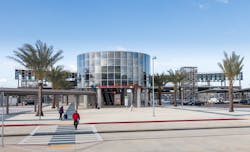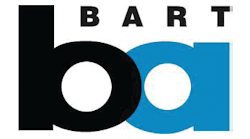Bay Area Rapid Transit (BART) debuted the agencies latest rail extension leading to the Warm Springs station in Fremont. The extension required combined work between the stakeholders and contractors to create a rail line that used aerial, subway and rail tracks that were designed at-grade.
Paul A. Medved, PE, group/project manager, BART Warm Springs Extension said that one of the most innovative features of the project was the station design itself. "It is designed to really make people want to be there. That part of Fremont has not been a particularly in demand location. It has light industry around it, a little agricultural land a little undeveloped land, so we had to be very careful about place making. We tried to create a station that would ultimately be the centerpiece of a lot of development around it," explained Medved. "It needed to look good, it needed to be unique, it needed to accommodate access by all kinds of modes from all directions and it was intended to make BART look like a 21st century transit system."
Medved said that the design of the station had an almost 'airport' look to it. Within the design Medved explained that they worked to take advantage of all the space. The station works to be energy efficient by incorporating solar panels and electric car charging — the station itself is powered by solar energy.
"We generate about half a megawatt of electricity onsite, which we are very proud of," said Medved. "We have a beautiful art component. There is glass that is built right into the entry of the station and the concourse curtain walls that is beautiful and almost cathedral like. I think that people love it and we certainly are proud of it. I think that is probably the part that everyone can relate to and immediately jumps out at you."
BART worked collaboratively with WSP USA and HNTB.
Anko Chen, principal architect, HNTB said, "I would say that the most important feature of the station design is focused on the passenger experience. In the past, most of the stations are focused on the core operations to keep the trains running and if the system is running we are happy with that. Now I think that we need to push it one step beyond, the passenger experience has become part of the important factors of designing the station."
Chen explained that the station flows passengers through the station.
"The stations design is such that you are going through a sequence of space, from the plaza that is surrounded by palm trees and landscape that accesses the rotunda," Chen said. "It comes into a really public room before you ascend to the concourse level where you have your ticketing and down to the platform area. In a way day in and day out people are going through this routine and they often see the rotunda because the high glass is designed in a way to give it a high visual. At different times of day it looks different."
The station was designed to feature sustainability. Chen added, "The green measure of this extension is one of the key features of the station design."
Tony Murphy, project manager for WSP said, "The initial impression that I am hearing is that the local residents are happy with the end result. They waited a long time for this and they got it, but only through the support of all the stakeholders. I think that speaks to the success of the program."
Launching the extension
Medved said that the Warm Springs extension was an important step in extending the BART line south of Alameda County into Santa Clara County. BART's goal is to reach into the San Jose area and there is currently another extension underway — without the Warm Springs station the rail lines wouldn't be able to reach it.
"The primary objective was to extend BART into Santa Clara County and secondly Fremont, the city that the Warm Springs extension exists within, has grown tremendously it’s really the edge of Silicon Valley. A lot of the growth of Silicon Valley has happened in Fremont, both residentialy, through employment and commercially," Medved said. He added that the new businesses that are moving into the area, including Tesla, are an important factor for BART to provide service for.
"The extension is actually a step for BART to pave the way down south to San Jose. This is a key development for BART. We wanted the station to be iconic, a new type of station experience, we focused on passenger experience," Chen said.
Murphy first came onto the project in 2005, but said that the latest leg of the project began back in 2002. WSP worked within two different contracts, the tunnel contract and the system stations contract — which was a design-and-build. "The turning portion was design-and-build so (WSP) was charged with the full design of the structural elements of the tunnel and the elements were the tunnel lighting and the supports associated with the tunnel operation."
HNTB came into the project in 2010.
"The major befit is opening up the South Freemont area to the BART system, previously they had to drive up to the downtown Freemont area to access it," Scott Fehnel, associate vice president and program manager, HNTB said. "That facility was very saturated so if you weren’t there by 6 a.m. the parking lot was full. That pushed people to the freeways. The ripple effect of benefits is amazing, fewer cars on the road is less gas consumed and there are a lot of positive aspects of having folks ride the train to work."
Overcoming challenges
This wasn't the first time that BART had attempted to move forward with the Warm Springs extension.
"The first was back in the 90’s. When a similar extension was proposed, but didn’t proceed to fruition. It made it through the preliminary phase, but it didn’t get environmental clearance. There was an issue almost directly related to outreach parties listening to one another and it had to do with how BART would extend through a very important park of Fremont – Fremont Central Park," explained Medved. "It’s a beautiful place and it is important to everyone in Fremont."
Medved said that the original proposal for the extension aimed to have an aerial structure running through Central Park, but the city of Fremont preferred a subway. BART worked to put out a great deal of information and reformed the proposed project. Medved said that BART worked with the community to create an open forum for questions and input. "We tried to remain good listeners and with the public we maintained an active community relations team," said Medved. "We benefited from really a tremendous amount of support from the city of Fremont and the residents of Fremont. You can hardly imagine a more supportive group for a project such as this."
Another challenge that arose was incorporating the old with the new.
"Part of what we did was we interfaced with an existing train control system and power system. With legacy systems — and it’s not unique to BART it’s any transit agency — when you’re tying into an existing operating sub-system that are dated, you always have technical challenges,"explained Murphy. "We worked both with the stakeholders within BART, the suppliers on the contractor side and had a good collaborative effort to tie in. Now there were some technical challenges, but we systematically went through them. I think that was good. When you’re adding new technology to something that was old you find things that you didn’t anticipate, but generally it was executed very well."
"There were some issues in the tunnel, we built a bridge over the Hayward Fault, which was structural," said Murphy. "There were issues like that that were more really innovative for the alignment compared to other alignments."
The Hayward Fault is around 74 miles long and the rail line happens to cross the fault in two different locations.
"The original forefathers and probably some foremothers of the BART system were really smart people, but unfortunately aimed the line that runs down from Oakland to Freemont essentially right at the Hayward Fault and stopped right in front of it. Our first task, at least geographically, immediately south of the 45-year-old Freemont Station was to cross the Hayward Fault on a structure. It’s a challenging configuration, we devoted a lot of time to making sure that that structure would be robust enough to deal with the constant creep that happens as well as an anticipated rupture that is probably due," said Medved.
Medved explained that they looked at the possibility of an earthquake is 'not a question of if, but when'. There needed to be a great deal of attention that went into the structural development in the crossing of those two locations. "Had the original alignment of the BART line down to Freemont been just a little further to the west we might have missed the whole thing, but instead we get to cross it twice. The second one is much more mundane, it is at grade and not nearly the challenge that the crossing it on the structure posed," said Medved.
Focusing on the fault crossings was a highly important factor.
"We did a couple of things. Number one is that it had to be designed for the most robust for our seismic criteria including near fault affects so it gets a very robust structural analysis and then the way we configured it was actually without deep pile foundations, rather on essentially a floating foundation and because there’s no amount of structure that is going to withstand the forces in a situation like that so the best thing you can do is roll with it and let the movement happen and maintain as much stability at the track level that you can possibly sustain," explained Medved.
There was an extra degree of movement that was factored into the abutment where the fault ran through. Fehnel explained that the track was also designed to be wider than typical to accommodate if the fault moved.
"The firm bridge design experts worked with some professors from Cal Berkeley and came up with the unique solution there to construct a forced transfer slab underneath the northern upper abutment. That enabled the bridge to survive an earthquake of an expected magnitude of 7.5 on the rector scale, which is a pretty large earthquake. So it can survive a horizontal displacement of the two planks of four feet and a vertical displacement of three feet," said Fehnel. "If that occurred nothing would be going on in the project, but the bridge would be secure."
Keys to a successful launch
"Several things that I would say is working closely with the stakeholders. I think that BART did an excellent job on that, we assisted them in that process. Working collaboratively with the contractors, there’s always challenges with these types of projects," said Murphy. "I would say that consistency in personnel is also very important, both for the history of the project and how the contractor got to the project. The handover process to the main stakeholder is a critical process because sometimes the focus of the program is all about the front end, but sometimes you have to look at the back end and the folks that really have to work with the asset for the next thirty/forty years."
Murphy said that he believes that collaboration from start to finish is important for a successful transition from a capital delivery program into a revenue service.
BART debuted the Warm Springs station with an event on March 24 and officially launched service on March 25.
"We had been in a testing period for some time before that and it was somewhat unclear when we would emerge from that so we didn’t have a lot of time to put out notice and we had about three weeks or so before we completed all the work," explained Medved. "We went to the public utilities commission, presented them with our safety and security package, got the green light and then moved forward with the event. So it was pretty quick that it all took shape, it turned out very well. Of course that Friday the 24th was a cool breezy rainy day, but the entryway to the station afforded enough room for a lot of happy people. It was a reunion of sorts for all of the people that had been making this happen for a long time."





